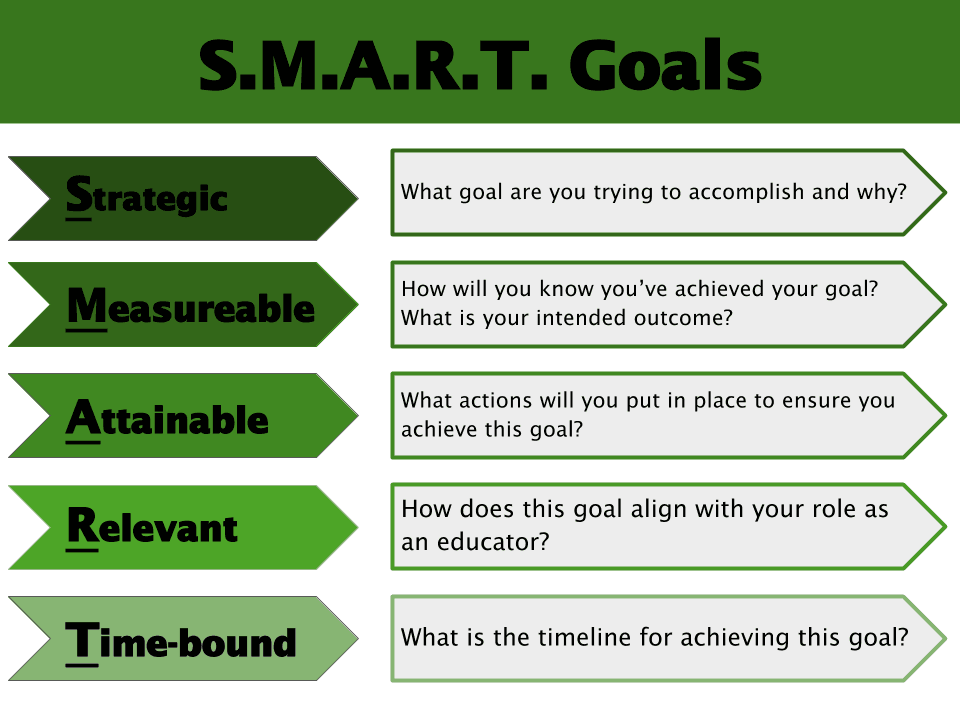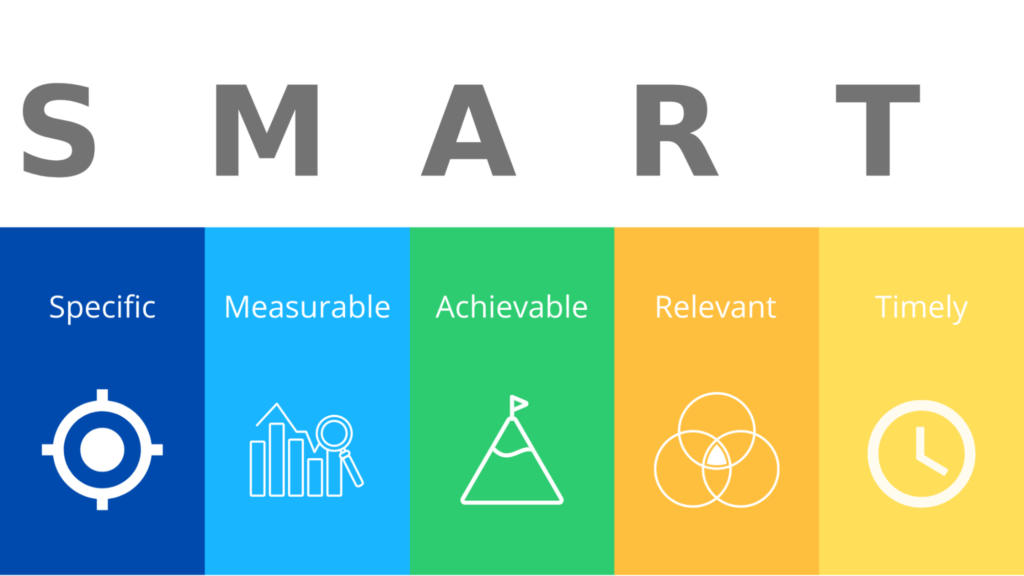As an educator, setting goals is crucial for personal and professional growth. SMART goals provide a framework that helps teachers create specific, measurable, attainable, relevant, and time-bound objectives. By setting SMART goals, teachers can enhance their teaching practices, improve student outcomes, and foster a positive learning environment. In this article, VTJ will provide SMART teacher goals examples for educators to refer to and apply to their teaching careers.

What are SMART Goals?
SMART goals are a framework designed to guide individuals in creating objectives that are not only achievable but also effectively impactful. The acronym “SMART” stands for Specific, Measurable, Attainable, Relevant, and Time-bound. Each of these elements contributes to the creation of goals that are well-defined, trackable, and aligned with personal and professional aspirations.

Specific
SMART goals should be clear and specific, leaving no room for ambiguity. Instead of setting a general goal like “improve my teaching skills,” a specific goal could be “enhance my classroom management techniques to reduce disruptions and improve student behavior.”
Measurable
Goals should be measurable to track progress and determine success. By including measurable criteria, individuals can assess their achievements and identify areas for improvement. For example, a measurable goal could be “increase student engagement by implementing interactive activities in at least three lessons per week.”
Attainable/Achievable
It is important to set goals that are challenging yet within reach. Setting unattainable goals can lead to frustration and demotivation. For instance, a goal like “completely eliminate student misbehavior” may not be achievable, but a goal like “reduce student misbehavior incidents by 50% through implementing a behavior management system” is more realistic.
Relevant/Realistic
The goal should be aligned with broader objectives, making it relevant to the individual’s overall purpose and direction. A SMART goal must be realistic, taking into account the available resources, capabilities, and limitations.
Time-bound/Tangible
SMART goals should have a specific timeframe for completion. Setting a deadline creates a sense of urgency and helps individuals stay focused and accountable. For instance, a time-bound goal could be “complete a professional development course on instructional technology within the next three months.”
Explore More Teaching Tips: 120+ High and Middle School Debate Topics for Students
Why is It Important for Teachers to Set SMART Goals?

Setting SMART goals is crucial for teachers as it provides numerous benefits for their personal and professional growth. Firstly, SMART goals help teachers clarify their objectives and focus their efforts on specific areas of improvement. By having clear goals, teachers can prioritize their actions and allocate their time and resources effectively. Secondly, setting goals keeps teachers motivated and encourages continuous growth. SMART goals provide a sense of purpose and direction, allowing teachers to stay focused on their professional development. By regularly setting and achieving goals, teachers can enhance their teaching practices, expand their knowledge, and improve their instructional strategies.
Moreover, SMART goals assist teachers in planning their lessons, activities, and assessments more effectively. By aligning their goals with the curriculum and student needs, teachers can create engaging and meaningful learning experiences. This leads to improved student outcomes and a positive impact on student achievement. SMART goals provide a framework for accountability and evaluation. By setting specific and measurable goals, teachers can track their progress and assess the effectiveness of their strategies. This allows for adjustments and improvements, ensuring that teachers are constantly striving for excellence in their teaching practices.
22+ SMART Teacher Goals Examples in 2025

SMART Teacher Goals Examples for Classroom Management
- Example 1: Every morning, I will update the classroom board with the daily homework, the standard being taught, and essential questions. I will maintain this routine until the end of the school year, reflecting weekly to ensure consistency.
- Example 2: Every Friday after school, I will dedicate 20 to 30 minutes to organize my desk, cabinets, and student areas to maintain an orderly environment.
- Example 3: Implement strategies to promote a positive and inclusive classroom culture, such as implementing a class reward system, recognizing and celebrating student achievements, and encouraging peer collaboration. Set a goal to have 90% of students reporting a positive classroom climate on end-of-year surveys.
- Example 4: Attend professional development workshops or courses on positive behavior interventions and supports (PBIS) or other evidence-based behavior management techniques. Set a goal to reduce the number of behavior incidents by 50% by the end of the school year.
Discover Related Guides: 40+ Preschool Teacher Interview Questions (+Answers)
SMART Teacher Goals Examples for Student Engagement
- Example 1: Implement strategies such as think-pair-share, group discussions, and interactive activities to encourage active participation from all students in the classroom.
- Example 2: Develop and implement a reward system that recognizes and celebrates students’ achievements, progress, and effort, fostering a positive learning environment and encouraging students to stay engaged.
- Example 3: Incorporate more group projects and cooperative learning activities into lesson plans, providing opportunities for students to work together, share ideas, and learn from one another.
- Example 4: Integrate educational technology tools and resources into lessons to enhance student engagement, such as interactive presentations, online simulations, and educational apps that provide hands-on learning experiences.
- Example 5: Integrate real-life examples, case studies, and current events into lessons to demonstrate the relevance and practical applications of the subject matter, increasing student engagement and interest.
SMART Teacher Goals Examples for Professional Development
- Example 1: Attend at least three professional development workshops or conferences related to my subject area within the next academic year, increasing my knowledge and skills by 20%.
- Example 2: Complete a certification course in a new teaching methodology or instructional strategy by the end of the school year, achieving a minimum score of 90% on the final assessment.
- Example 3: Engage in regular self-reflection and seek feedback from colleagues to identify areas for professional growth and create a personalized professional development plan to address those areas, implementing at least two strategies from the plan within the next semester.
SMART Teacher Goals Examples for Technology Integration
- Example 1: Successfully integrated a new educational technology tool into my classroom instruction, increasing student engagement by 25% and demonstrating its impact through pre- and post-assessments.
- Example 2: Attend at least two technology-focused professional development sessions or workshops, acquiring new skills and knowledge that can be applied in the classroom, and sharing the gained knowledge with colleagues through a presentation or workshop.
- Example 3: Collaborate with colleagues to develop and implement a technology-infused project or activity that promotes critical thinking and problem-solving skills among students, achieving a minimum of 80% student satisfaction based on feedback surveys.
SMART Teacher Goals Examples for Differentiated Instruction
- Example 1: Develop and implement a variety of instructional strategies and materials to cater to diverse learning styles and abilities, increasing student engagement and achievement by 15% based on formative and summative assessments.
- Example 2: Attend professional development sessions or workshops focused on differentiated instruction, applying at least three new strategies in the classroom and documenting their impact on student learning.
- Example 3: Regularly assess student progress and adjust instruction accordingly to meet individual needs, providing targeted support and enrichment opportunities as necessary, and maintaining a record of student growth and progress throughout the year.
SMART Teacher Goals Examples for Formative Assessment
- Example 1: Implement a variety of formative assessment strategies, such as exit tickets, quizzes, and observations, to gather ongoing feedback on student learning and adjust instruction accordingly, increasing student performance by 10% based on formative assessment data.
- Example 2: Attend professional development sessions or workshops on formative assessment techniques, implementing at least two new strategies in the classroom and analyzing their effectiveness through student work samples and reflections.
- Example 3: Provide timely and constructive feedback to students based on formative assessments, helping them understand their strengths and areas for improvement, and maintaining a record of student progress and growth throughout the year.
Continue Learning: 14 Types of teaching methods for an effective lesson
SMART Teacher Goals Examples for Parent-Teacher Communication
- Example 1: Establish regular and effective communication channels with parents, such as weekly newsletters, email updates, or parent-teacher conferences, increasing parent engagement and satisfaction by 20% based on feedback surveys.
- Example 2: Implement strategies to involve parents in their child’s learning, such as providing resources and suggestions for supporting learning at home or organizing parent workshops on relevant topics, with at least 80% of parents reporting increased involvement in their child’s education.
- Example 3: Seek feedback from parents through surveys or informal conversations to understand their perspectives and continuously improve communication and collaboration, implementing at least two changes based on parent feedback and evaluating their impact on parent satisfaction.
SMART Teacher Goals Examples for Classroom Environment
- Example 1: Create a positive and inclusive classroom environment by establishing clear expectations, promoting respect and empathy among students, and addressing any instances of bullying or exclusion promptly, reducing disciplinary incidents by 15% based on behavior records.
- Example 2: Incorporate elements of student choice and autonomy in classroom activities and assignments to foster a sense of ownership and engagement among students, with at least 80% of students reporting increased motivation and enjoyment in learning.
- Example 3: Regularly assess and adjust the physical layout and organization of the classroom to optimize learning and create a welcoming and comfortable environment for students, implementing at least two changes based on student feedback and evaluating their impact on student satisfaction.
SMART Teacher Goals Examples for Teacher Well-being
- Example 1: Implement a daily mindfulness practice to reduce stress and promote well-being. Engage in at least 10 minutes of mindfulness practice every day. Set aside time each morning or evening for mindfulness practice and utilize available resources such as meditation apps or guided videos. To improve mental and emotional well-being, reduce stress levels, and enhance overall teacher effectiveness. Maintain the daily mindfulness practice for a minimum of three months and evaluate its impact on well-being.
- Example 2: Establish a healthy work-life balance by setting boundaries and prioritizing self-care. Dedicate at least two evenings per week to personal activities or hobbies outside of work. Create a schedule that includes designated time for self-care activities and communicate boundaries with colleagues and administrators. Aim to prevent burnout, maintain a positive work-life balance, and improve overall well-being. Maintain the established work-life balance routine for the entire academic year.
- Example 3: Engage in regular physical exercise to improve physical health and well-being. Participate in at least three exercise sessions per week, each lasting a minimum of 30 minutes. Identify preferred forms of exercise (e.g., walking, yoga, swimming) and schedule exercise sessions accordingly. Aim to enhance physical fitness, reduce stress, and improve overall well-being. Maintain the exercise routine for a minimum of six months and track progress towards fitness goals.
Continue Learning: Why do you want to be a Teacher? 15+ Example Answers
SMART Teacher Goals Examples for Community Involvement
- Example 1: Organize and lead a monthly community service project in collaboration with local organizations. Engage at least 20 students and complete four community service projects throughout the academic year. Allocate one hour per week to plan and coordinate community service activities. Foster a sense of social responsibility and empathy among students while making a positive impact on the community. Begin the first community service project by the end of September and continue monthly until May.
- Example 2: Establish partnerships with local businesses to provide internship opportunities for students. Secure at least five internship placements for students in relevant fields. Research and reach out to local companies to explore internship possibilities. Enhance students’ career readiness and expose them to real-world experiences in their areas of interest. Have all internship placements confirmed by the end of the second semester.
- Example 3: Collaborate with local community organizations to organize a career fair for students—secure participation from at least 15 local businesses and professionals. Establish connections with community organizations and send out invitations to potential participants. Expose students to a variety of career options and provide networking opportunities with professionals in different fields. Plan and execute the career fair within the first semester of the academic year.
These SMART teacher goal examples demonstrate the versatility of this framework in improving various aspects of teaching and classroom dynamics. By setting goals that are specific, measurable, attainable, relevant, and time-bound, educators can make a lasting impact on their student’s learning experiences and their own professional growth. Hopefully, through smart teacher goals examples, educators can set goals and implement them more effectively.
Continue Learning: 40+ ESL Teacher Interview Questions & Answers
FAQ
What are the 4 main goals of effective teachers?
The four main goals of effective teachers are to promote student engagement, create a positive and inclusive classroom environment, continuously improve their teaching practices, and foster the overall development and success of their students.






